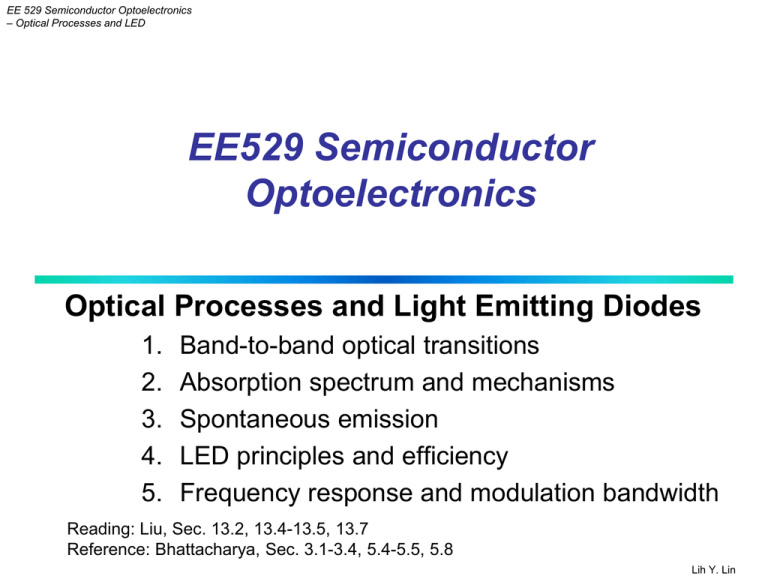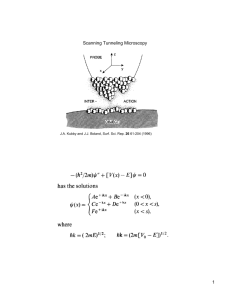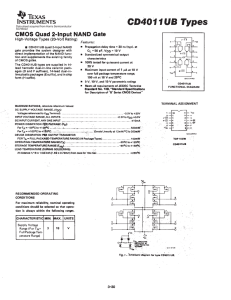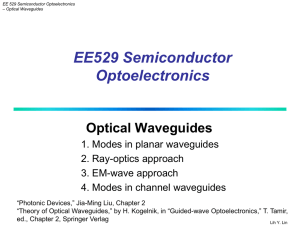EE529 Semiconductor Optoelectronics Optical Processes and Light Emitting Diodes
advertisement

EE 529 Semiconductor Optoelectronics – Optical Processes and LED EE529 Semiconductor Optoelectronics Optical Processes and Light Emitting Diodes 1. 2. 3. 4. 5. Band-to-band optical transitions Absorption spectrum and mechanisms Spontaneous emission LED principles and efficiency Frequency response and modulation bandwidth Reading: Liu, Sec. 13.2, 13.4-13.5, 13.7 Reference: Bhattacharya, Sec. 3.1-3.4, 5.4-5.5, 5.8 Lih Y. Lin EE 529 Semiconductor Optoelectronics – Optical Processes and LED Schrödinger’s Equation and Probability Schrödinger’s Equation: ∂Ψ 2 ∂ 2Ψ i = − + V Ψ 2 ∂t 2m ∂x Potential energy Total energy Ψ ( x, t ) Kinetic energy Position operator: x Momentum operator: Energy operator: i ∂ ∂t ∂ i ∂x : Wave function of a matter wave 2 ∫a | Ψ ( x, t ) | dx : Probability of finding the particle between a and b at time t b Lih Y. Lin 2 EE 529 Semiconductor Optoelectronics – Optical Processes and LED Solving Schrödinger Equation Assume time-independent potential V(x). 1. Solve the time-independent Schrödinger Equation. 2 d 2ψ − + V ψ = Eψ 2 2m dx Obtain ψn(x) with associated energy En. 2. Initial wave function: ∞ Ψ ( x,0) =∑ cn ψ n ( x) n =1 Cn can be obtained by matching initial conditions. 3. Wave function at subsequent time t: ∞ Ψ ( x, t ) =∑ cn ψ n ( x)e − iEn t / ∞ =∑ cn Ψ n ( x, t ) = n 1= n 1 Lih Y. Lin 3 EE 529 Semiconductor Optoelectronics – Optical Processes and LED Infinite Square Well Potential V(x) Eigenfunction: 2 nπ ψ ( x) = sin x a a E3 E2 E1 0 a Quantized energy: x 2 kn 2 n 2π 2 2 En = = 2m 2ma 2 Wave function: ∞ Ψ ( x, t ) = ∑ cn n =1 2 nπ sin a a x e − i ( n π / 2 ma ) t 2 2 2 Expectation value of the energy: ∞ H = ∑ | cn |2 En n =1 Lih Y. Lin 4 EE 529 Semiconductor Optoelectronics – Optical Processes and LED Direct Bandgap vs. Indirect Bandgap Direct bandgap E • Recall that photon momentum is very small, compared to electron momentum. CB Direct Bandgap Ec Eg ( p = k ) Photon • Momentum conservation can be satisfied in direct bandgap semiconductors. • Can be good photon absorbers and emitters. Ev VB –k k (a) GaAs Indirect bandgap E E Indirect Bandgap, Eg CB kcb –k VB kvb (b) Si Ec CB Er Ev Ec Phonon Ev VB k –k (c) Si with a recombination center • Momentum conservation cannot be satisfied with photon-only process in indirect bandgap semiconductors. • Can be good photon k absorbers, but not good photon emitters. Lih Y. Lin 5 EE 529 Semiconductor Optoelectronics – Optical Processes and LED Band-to-Band Absorption and Recombination Momentum of photons and electrons p = h/λ → Photon momentum << Electron Momentum Absorption and emission in direct bandgap Emission in indirect bandgap Absorption in indirect bandgap Defect center ε ph = ω εg + ε p ω= e ω= εg − ε p a e.g. GaAs, InP Involves emission of a phonon e.g. Si, Ge Involves absorption or emission of a phonon Lih Y. Lin 6 EE 529 Semiconductor Optoelectronics – Optical Processes and LED Exercise: Determine bandgap and phonon energies from absorption experiment The figure below shows the absorption for Ge at 300K and 77K. Analyze the 300K data to obtain the value of the direct bandgap, the indirect bandgap, and the phonon energy participating in the indirect transitions. Note: The band structure of Ge shows possibilities of indirect and direct transitions. The values we obtain from this exercise will be different from the calculated data at 0K. (Source: Kittel, “Introduction to Solid State Physics”) Lih Y. Lin 7 EE 529 Semiconductor Optoelectronics – Optical Processes and LED Absorption Spectrum of a Typical Semiconductor (Source: Wolfe, Holonyak, and Stillman, “Physical Properties of Semiconductors) Lih Y. Lin 8 EE 529 Semiconductor Optoelectronics – Optical Processes and LED Exciton Absorption Q: Exciton absorption peaks are normally seen in very pure semiconductors at low temperatures. Higher degree of confinement in the semiconductors also greatly helps observing these, e.g., quantum wells. Why? Lih Y. Lin 9 EE 529 Semiconductor Optoelectronics – Optical Processes and LED Calculated Absorption Spectrum due to Franz-Keldysh Effect Lih Y. Lin 10 EE 529 Semiconductor Optoelectronics – Optical Processes and LED Quantum-Confined Stark Effect (QCSE) Lih Y. Lin 11 EE 529 Semiconductor Optoelectronics – Optical Processes and LED Relation between Absorption and Spontaneous Emission 8πn 2 ν 2 α 0 (ν) R (ν ) = 2 c e hν / kBT − 1 0 sp Roosbroeck-Shockley relation Spontaneous emission spectrum of GaAs at 300K Lih Y. Lin 12 EE 529 Semiconductor Optoelectronics – Optical Processes and LED Light Emitting Diodes A p-n junction diode typically made from a direct bandgap semiconductor. Electron-hole pair recombination results in the emission of a photon. Spontaneous emission; emitted photons in random direction. Principles Electron energy n+ p Ec eVo (a) EF Ec EF Eg n+ p Eg (b) hυ - Eg Ev eVo Ev Distance into device V Electron in CB Hole in VB Device Structures Light output Light output p n+ Epitaxial layers n+ n+ Substrate (a) Metal electrode Insulator (oxide) p n+ Epitaxial layer Substrate (b) Lih Y. Lin 13 EE 529 Semiconductor Optoelectronics – Optical Processes and LED Heterojunction LEDs n+ (a) AlGaAs p p GaAs Avoid re-absorption of photons along the emission path. AlGaAs ~ 0.2 µm Electrons in CB eVo EF Ec (b) Ec ∆Ec (a) A double No bias heterostructure diode has 2 eV 1.4 eV EF Ev 2 eV Holes in VB Ev (b) A simplified energy band diagram with exaggerated features. EF must be uniform. With forward bias (c) n+ p p two junctions which are between two different bandgap semiconductors (GaAs and AlGaAs) (c) Forward biased simplified energy band diagram. (d) Forward biased LED. Schematic illustration of photons escaping reabsorption in the AlGaAs layer and being emitted from the device. (d) AlGaAs GaAs AlGaAs Lih Y. Lin 14 EE 529 Semiconductor Optoelectronics – Optical Processes and LED Exercise: LED Efficiency An AlGaInP/GaP LED with peak emission wavelength of 636 nm has an external quantum efficiency of 25%. (a) To achieve 5 mW of output optical power, what should be the injected current? (b) If this corresponds to forward-biasing the device at 2 V, find its power conversion efficiency. (c) Find its luminous efficiency and luminous flux. Lih Y. Lin 15 EE 529 Semiconductor Optoelectronics – Optical Processes and LED Photon Escape Efficiency The intensity distribution of the LED radiation is Lambertian. At the semiconductor-air interface, if the incident angle is greater than the critical angle 𝜃𝑐 = sin−1 (𝑛𝑎𝑎𝑎 ⁄𝑛𝑟 ), total internal reflection occurs and the light is trapped inside the semiconductor. Possible solutions: (a) Shape the semiconductor surface as a hemisphere (expensive). (b) Encapsulate the LED in a transparent dome with higher refractive index than air to increase 𝜃𝐶 . Lih Y. Lin 16







